Zenyatta is 20 years old. Her legend in horse racing still shines bright
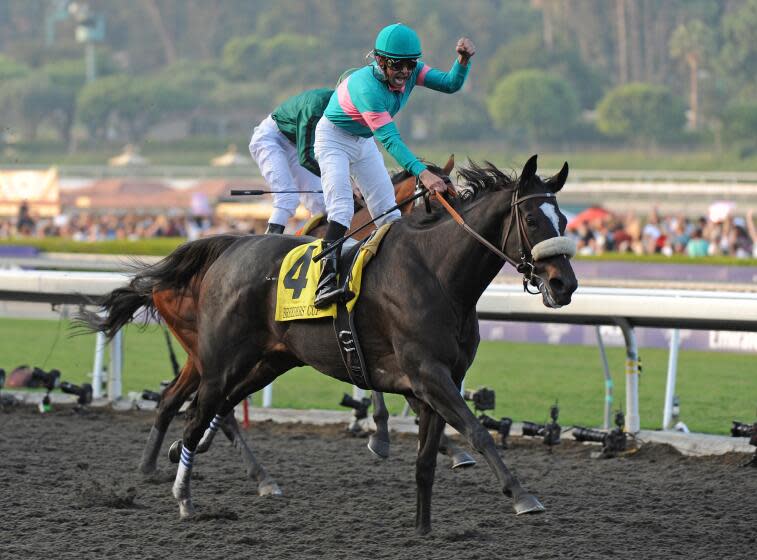
Horse racing never wanted the Zenyatta story to end, never wanted her pre-race dance steps to go away and her improbable last-to-first mad dashes to stop. But time intrudes and the Zenyatta story has drifted off, needing a milestone to rekindle the memories.
A milestone, indeed. Zenyatta turns 20-years-old Jan. 1.
Actually, as in many things in the sport, even that is a little confusing. All thoroughbreds turn a year older on the first day of the new year. Zenyatta was born April 1, 2004. She was the daughter of Street Cry, who fathered a Kentucky Derby winner named Street Sense, but had no greater moment as a sire than Zenyatta’s birth.
Zenyatta was owned by the recently deceased Jerry Moss and his wife, Ann, who did the unthinkable by letting her run a year longer than the sort’s norm. She was at the top of her game when the Mosses called a small gathering of sportswriters to their box at Santa Anita one day to tell them they had decided to race their wonder mare one more year, her sixth. She was worth a Brink's truck of money for her breeding rights and the odds of an injury coming along soon were great. But the Mosses said that racing deserved to see as much as possible of her.
Read more: California horse racing is at a crossroads. Can it survive?
The Mosses purchased the big filly in 2005 at a September auction at Keeneland. They had taken the advice of bloodstock agent David Ingordo, whose mother, Dottie, ran their racing operation and still does. For bidding purposes, the then-unnamed Zenyatta was Hip No. 703, and when the bidding stopped at $60,000 and the filly went to the Mosses, David Ingordo was so stunned at the bargain price that he hustled over to take a look, fearing that somehow he had given them the wrong horse or there had been a mix-up on the bid number.
With great relief, he saw that the Mosses and his mother had purchased the horse he had singled out. The only reason he could think that the bargain price stuck was that she was such a big horse, she might have scared some buyers off. Also, she had entered the bidding ring with a skin rash. The size of horse was a plus for Ingordo, because he knew the filly would eventually be trained by John Shirreffs, Dottie’s husband and his stepfather, who liked to train large horses.
The Mosses named her Zenyatta, which was half of the name of a 1980 hit album by British rock group The Police. Jerry Moss partnered with hit record musician Herb Alpert to form A&M Records. The Police album, produced by A&M, was called Zenyatta Mondatta. It featured the hit song “Don’t Stand So Close to me.” It became No. 1 in several countries, sold three million albums in the United States and millions more worldwide. The words “Zenyatta” and “Mondatta” were just made up. The horse named for the album turned out to be very real. Eventually, she brought to horse racing a warmth and attraction that even PETA (People for the Ethical Treatment of Animals) wouldn’t deny.
Zenyatta was a slow starter. She didn’t race until late in her third year. She was too big (ending up racing eventually at 17 hands and about 1,245 pounds) and too slow developing, so the Triple Crown, for three-year-olds only, was never on the table for the Mosses and Shirreffs. But once Shirreffs got her to the track, a maiden special at Hollywood Park on Nov. 22, 2007, racing was about to get three years of shock and awe.
In that first race, with 11 competitors, she broke last. After a half mile, she was in 10th place, which raised some eyebrows when she won by three lengths. It was an early sneak preview. The end of a horse race is usually thrilling for race fans, even if it’s only a $2 bet at stake. But what the sport was about to witness with Zenyatta defied description. Other horses shot out of the gate. Zenyatta dawdled. Other horses scrambled and jockeyed for position all the way around. Zenyatta stay removed from the fray, sidling along like an outsider amused by all the foolishness. When it was time to run, she kind of swerved around them, usually stayed mostly clear to the outside and just ran past them.
This eventually led to two of the most famous scenes in the history of the sport.
Breeders' Cup Classic, Santa Anita Park — 2009
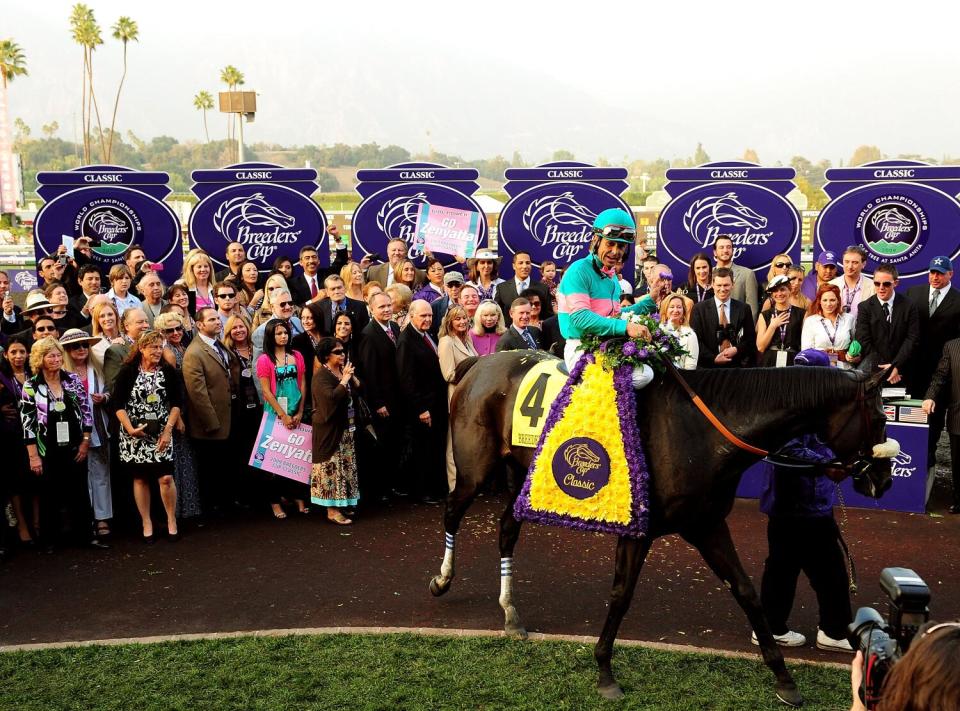
It was Nov. 7. The annual richest day in horse racing arrived with the buzz about Zenyatta. She had won the Breeders’ Cup Ladies Classic the year before and now she was going to take on the boys in the main event. These weren’t just scrappy kids of the same age, like the Kentucky Derby. Many of her competitors had raced a lot, won a lot and thrived on the macho pushing shoving around the oval. The Breeders’ Cup Classic attracted some horses as old as four and five — tough, ornery veterans. The field included more than a dozen stakes winners, as well as a Kentucky Derby winner and a Belmont Stakes winner.
But the favorite was Zenyatta, even though she was a mare and racing in her five-year-old season. There was $2.7 million set to go to the winner. There were 58,825 in attendance. Creaky old Santa Anita was about to have a resurrection. The Great Race Place would be great again, at least for a day.
At the starting gate, Zenyatta was hesitant. Was she not used to having all those males around? She finally loaded, but then Quality Road acted up at the gate, causing more delay, and was finally scratched. Quality Road later became an interesting side note in the Zenyatta story.
When the horses eventually broke from the gate, Zenyatta, as usual, dawdled. With a quarter of a mile to go in the 1¼-mile race, she was still about seven lengths back. Almost casually, veteran jockey Mike Smith steered Zenyatta to the outside and away she went.
Santa Anita went bonkers. The word “crescendo” was created for moments like this. The noise soared like a jet airplane on take-off. Seldom have 58,000 people, uniformly this vocally delighted and expressive, produced such an ear-piercing sound.
Smith, who had made the dash down this homestretch thousands of times, was stunned. “I never heard anything like that,” he said. “The ground was shaking like an earthquake and there wasn’t one.”
In the track announcer’s booth, Trevor Denman — who knew enough to keep his eye on Zenyatta, even though she looked more beaten than usual — saw it coming and stirred the fans’ emotional pot.
“Zenyatta is flying on the grandstand side,” he intoned, with quickly turned-up volume.
Then came the unrehearsed and classic cadence-call finish, one that will forever be his signature call and Zenyatta’s moment. As she was about to cross the line by a length in front of Gio Ponti, Denman defined and amplified history: “This. Is. Un-be-liveable.” The rest was drowned out by the sound of a shaking grandstand and the jet airplane screech of 58,000 people.
Denman finished, his volume still turned way up: “What a performance, one we’ll never forget.”
Read more: Bob Baffert among the top winners again on Santa Anita opening day
No one on hand that day would disagree.
As the horses cooled down, Shirreffs met Smith near the finish line and instructed him to take Zenyatta back up the home stretch near the grandstand so people could see her up close. The usual procedure was to head to the winners’ circle, but Shirreffs wanted as many as possible to get as close as they could to this magnificent horse. Smith did as he was told. And the still-hyped crowd loved it. Handkerchiefs waved, grown men cried and fathers and mothers put their children on their shoulders so they could get a better look at this wonder of the thoroughbred world.
She had carved out her place in racing history. She was the female Secretariat. He had thrilled them by winning with wide margins. She thrilled them by winning with great drama.
Breeders' Cup Classic, Churchill Downs — 2010
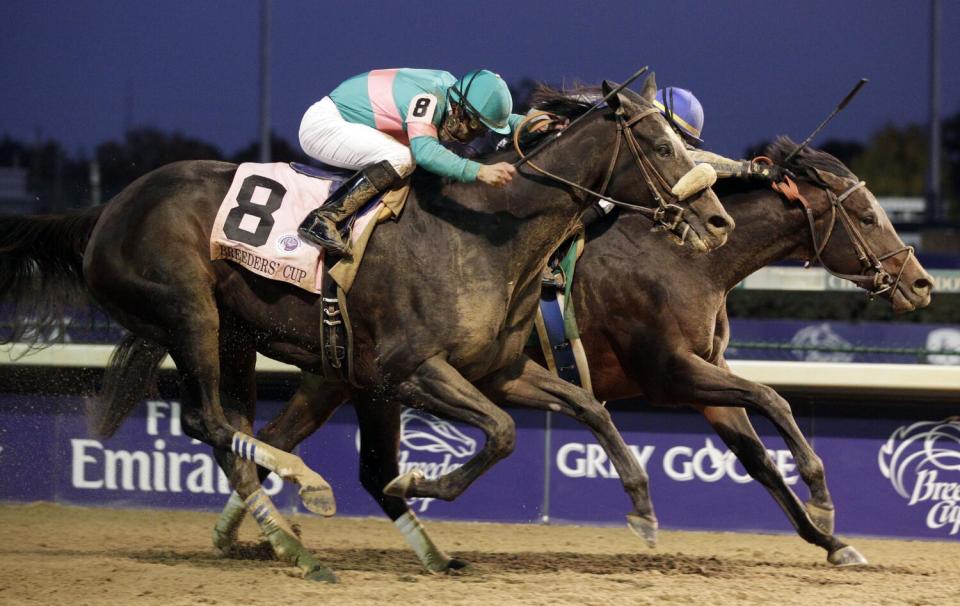
Even when the Mosses decided to run Zenyatta into her sixth year, there was no certainty that that would include another run against the boys in the Breeders’ Cup Classic. Only Tiznow had won twice, and Zenyatta was the only female winner then (and now). But Shirreffs had prepared her carefully and logically from race to race and soon it was obvious she was going to give it another try.
This would be her last race. She would finish her career with a 20-0 record if she won again. It was unthinkable: a six-year-old mare, who always let the field get way ahead, who would be facing yet another field of male maulers and doing so on a track that was unfamiliar, and at a twilight starting time in the East that would present her with unfamiliarity and a strange feel. It made little sense to the by-the-book guys on the backstretch.
Zenyatta was by no means a lucky gift to a lucky trainer. Shirreffs was a veteran who already had his share of big moments in racing, including Giacomo’s win at 50-1 odds in the 2005 Kentucky Derby. Smith rode Giacomo that day.
But this wasn’t a Triple Crown race. It was bigger.
While Shirreffs found his quiet spot to watch, Smith was struggling. He had already witnessed her go through a bit of an ordeal in the saddling paddock. It was more crowded than she was used to, even noisier than Santa Anita before big races. She did more dance steps than usual, doing her so-called “Spanish Walk” that had endeared her to so many fans. She almost always danced in the paddock before a race, and lots of times afterward. But Smith knew that at least some of this dancing was nerves, and she seemed to have lots of them this day. His fears appeared to be accurate as the race began.
“She started late,” Smith said, stating the obvious. “She just wasn’t comfortable.”
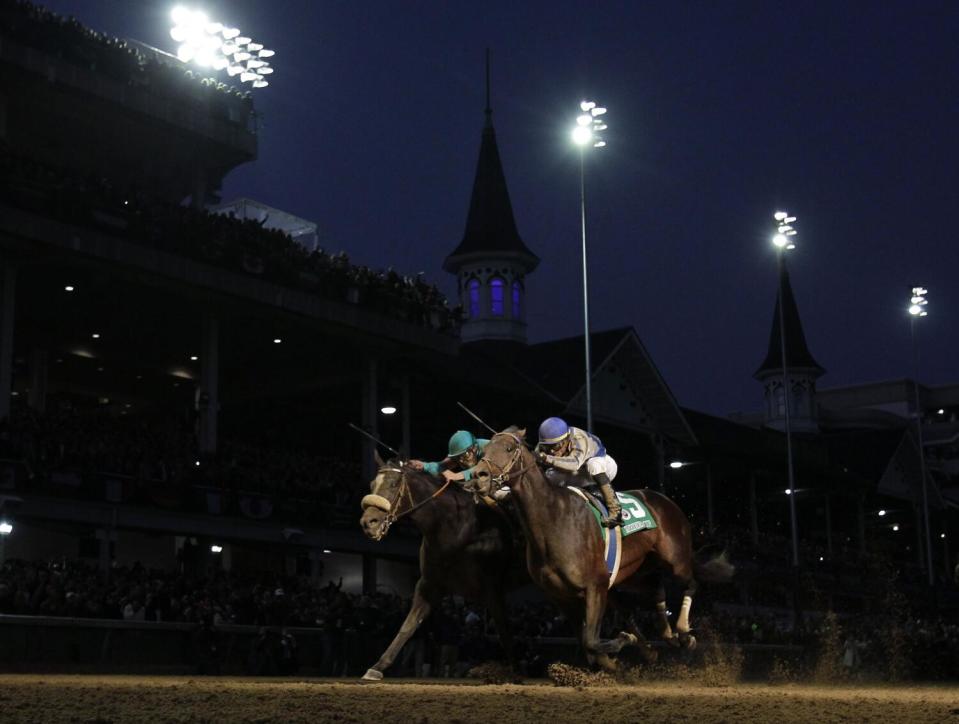
With a half a mile to go, she was 15 lengths back.
Shirreffs saw it, too.
“The light was different than she had ever experienced,” he said. “You never know what will affect a horse. And the field had split into two packs and she was running behind the second pack. I wondered if she thought that was the lead pack and she had plenty of time to go get it.”
Smith said, “I couldn’t get her closer. She just wasn’t comfortable. I even thought, if she didn’t find herself soon, I might just pull her up.”
Then, just as she stated to find her stride, Quality Road (remember him?) stopped in front of her and Smith had to pull up Zenyatta, take her around and regain momentum.
But suddenly, the long and determined stride was there and the crowd of Kentuckians were about to see first-hand the Zenyatta show about which they had heard so much.
On the rail, a Kentucky-bred horse named Blame, ridden by veteran California jockey Garrett Gomez, a friend of Smith’s, had the lead. Gomez said afterward that he had seen so much of Zenyatta and raced against her enough to know that he needed to have Blame save a little for her final dash.
“I was waiting for her, expecting her,” Gomez said after the race. “I could sense she was coming.”
So she was. Smith had a tight grip and was urging her, almost in desperation. She was once clocked in a home-stretch dash at 40 miles an hour. Smith said after one of her mad-dash victories at Del Mar, that she was going so fast he felt the skin on his face peel back, like an astronaut on re-entry.
But this time, one horse in the frantic finish was not just hanging on. Gomez had made sure Blame had something left. And so Zenyatta’s final sprint finally failed. This time by a neck, so close that many thought she had won.
Afterward, Smith was in tears, blaming himself for not getting her started in time. Gomez was apologetic, saying he wished it had been a different rider that wrecked the 20-0. Shirreffs was a bit amazed, saying that in the post-race test barn, the other horses were clearly exhausted, but Zenyatta was perky, playful, with her head held high.
“She recovered so fast,” Shirreffs said. “That made me feel a lot better.”
Read more: Del Mar gets back-to-back Breeders' Cups, will be awarded 2025 event
It was over. Zenyatta finished with a record of 19-1, total winnings of $7,304,580 and a fan base that arguable was the largest and most loyal since Secretariat and Seabiscuit.
A bit surprisingly, the on-site celebration of the victory by a Kentucky horse at a Kentucky track was not as raucous as might be expected. When it was clear that the sport’s queen had not quite pulled it off, that her one final streak to immortality had failed by the length of a yardstick, a quiet, almost a pall, fell over the place.
Jay Hovdey of the Racing Form captured the mood nicely in his story the next day: “There is no joy in Louisville. Mighty Zenyatta got beat in her last at-bat.”
The next morning’s edition of the Louisville Courier Journal said it even better, whether intentional or not. The headline read: BLAME THE WINNER.
The aftermath, the legend
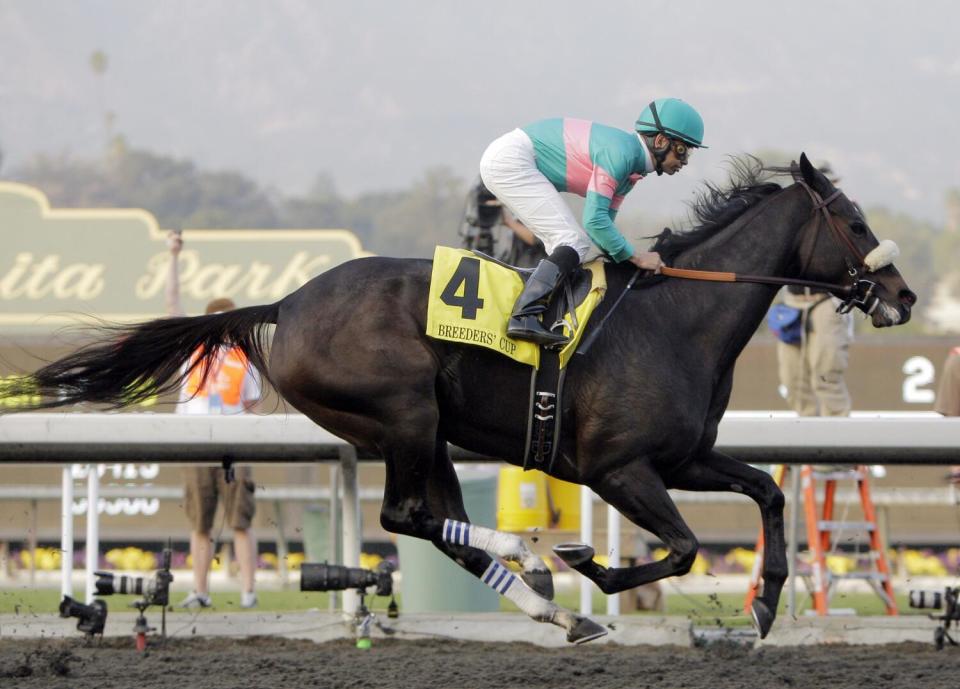
Zenyatta was shipped back to Hollywood Park for a few weeks, then returned to Kentucky and Land’s End Farm, about 40 minutes up the road from where she barely missed her perfect 20-0. There, she would begin her second career as a broodmare.
She was a celebrity from the day she arrived, just like she had been a celebrity in Barn 55 South at Hollywood Park, where Shirreffs trained. She danced around the barn. Sometimes she danced in a grassy area behind the barn. Other times, she stood and watched in fascination as squirrels ran up and down a nearby big tree.
During her success, Shirreffs decided that he needed to share her as much as possible with her public and her training days were filled with many visitors. When he got her, Shirreffs had said that he hoped she’d be his Michael Jordan. Recently, he said, “She was that and much more. When she was around, it was like we were living in Camelot. She took everyone there with her.”
Daily, hundreds of fans worked their way down Zenyatta Lane to Barn 55 South. Because of her fame, everybody there — hot walkers, exercise riders, assistant trainers — had become part celebrity and part worker. Shirreffs allowed it and loved it. The visitors watched and cheered when she got a bath, marveled when she was mesmerized by the squirrels, cheered as she did a few dance steps, and giggled in amazement as she drank her daily Guinness. A local reporter showed up with a bottle of Guinness for her one morning. Shirreffs thanked her and put the bottle in the refrigerator.
“She won’t drink her Guinness until the afternoon,” he said.
Much of the time, the clientele showing up to see Zenyatta was female. “Girl Power” signs were everywhere.
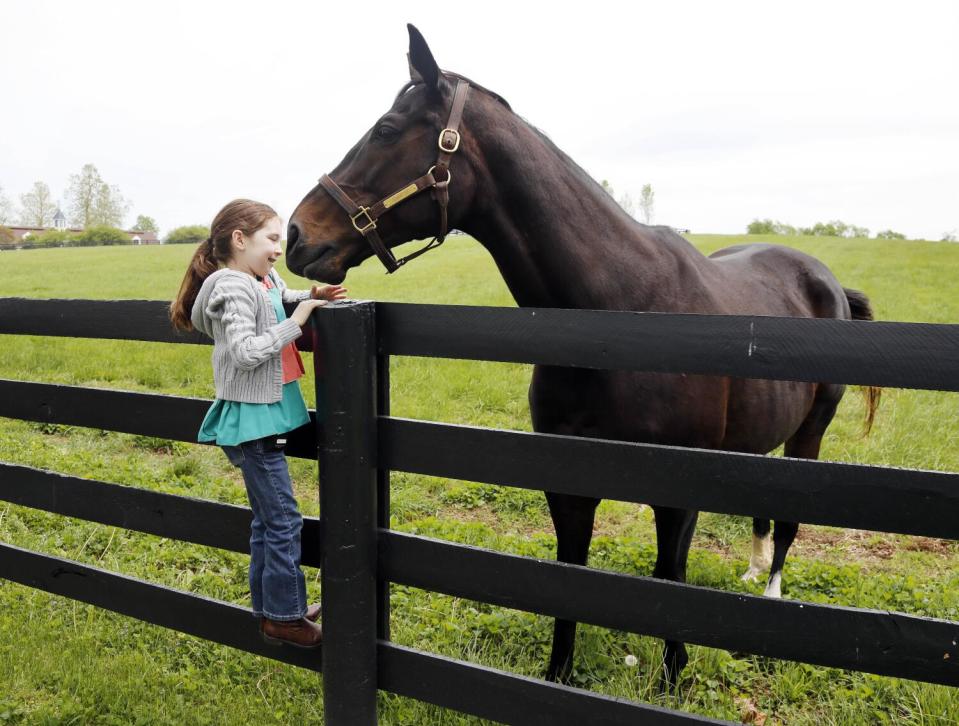
Zenyatta even made appearances at charity fundraisers, and Dottie Ingordo tells the story about the event in which a women left her purse on a nearby table as speeches were taking place. Zenyatta sidled over and started rummaging through the purse. Turns out, there were mints in there.
Zenyatta twice finished runner-up in national polls that picked the Female Athlete of the Year. She lost to Serena Williams and Lindsay Vonn. Again, oh so close. But, despite much lobbying on behalf of her Breeders’ Cup conqueror, Blame, she did win the Eclipse Award as Horse of the Year in 2010.
Zenyatta’s success on the track has not yet translated into success as a broodmare. She has been pregnant nine times, lost two babies to miscarriage, another to illness and yet another to an accident at Lane’s End. None of her other babies have won a race, although Ziconic was in the money eight times. Zilkha is in training now with Shirreffs and, on June 9, Zenyatta had a baby girl named Nymue. A worker at Lane’s End said that the name means “New Beginnings.”
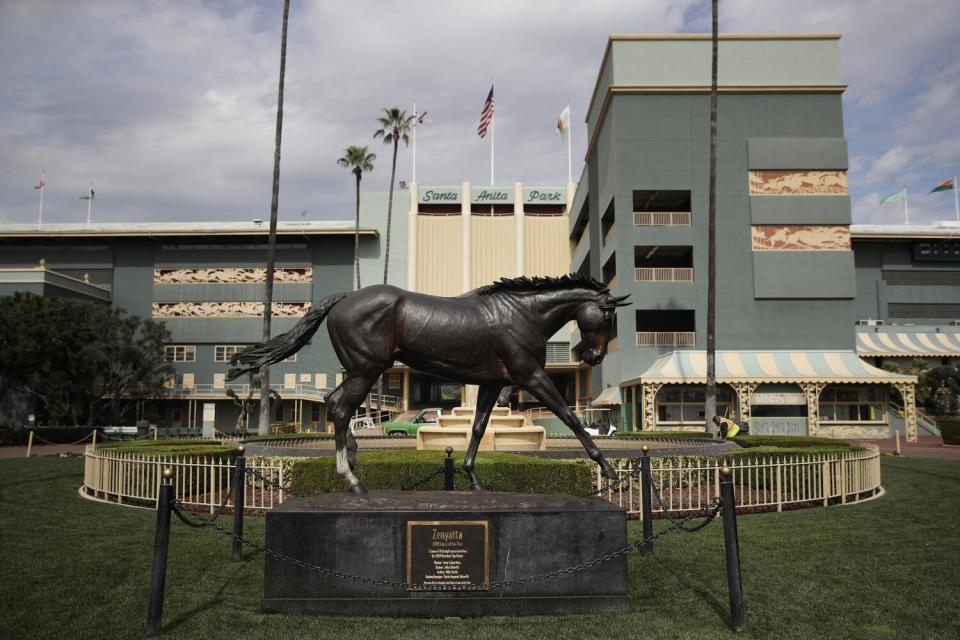
Zenyatta has now been retired from the breeding shed. The new baby reportedly looks and acts like her mother, almost to the point of being stunning. The blaze (white facial strip) is almost identical to mom’s. It will be several years until we know if any of that translates to racing genius, like Zenyatta’s. But it would somehow be fitting for her last foal to become her winner.
In the meantime, Zenyatta will live the spoiled life. She can dance to her heart’s content and probably will. She can run free, nap whenever she wants. Life will be different. But not completely.
Ingordo reports that, every month, when the bill for her upkeep comes in, there is a familiar line item.
For Guinness.
This story originally appeared in Los Angeles Times.

